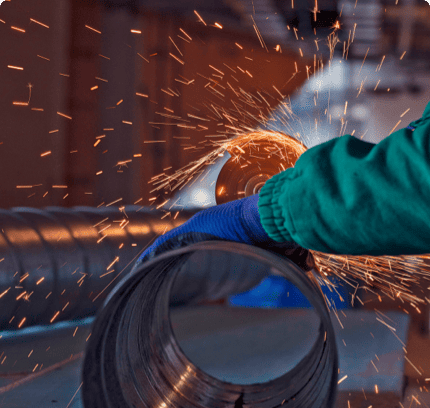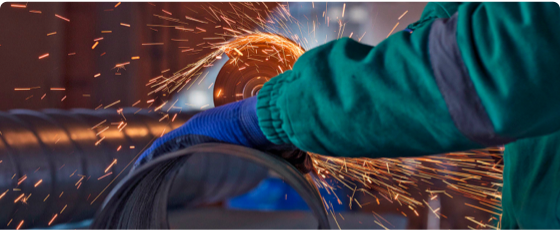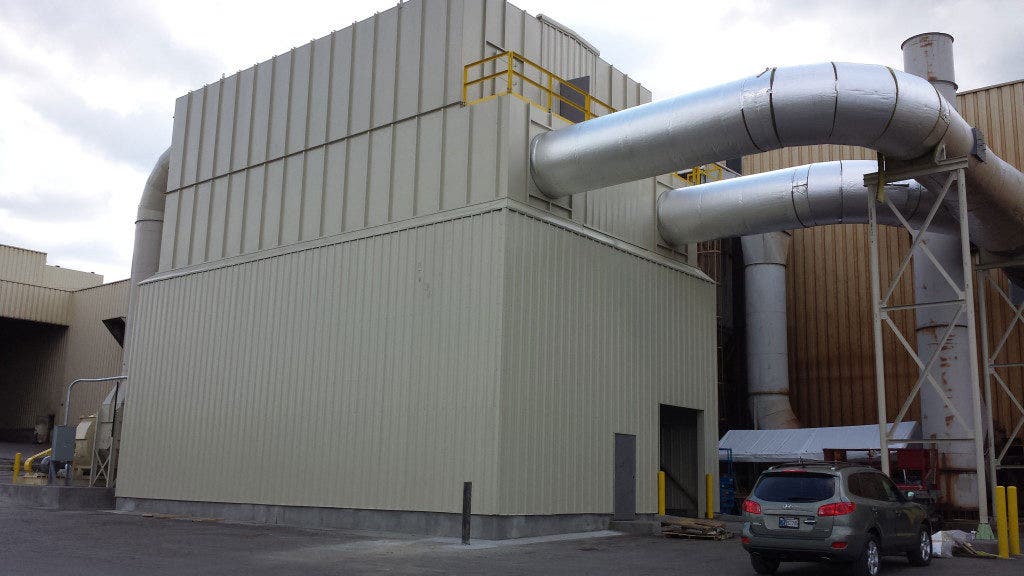....
Metalworking


MetalWorking
Metalworking processes create parts such as jewelry and motor components, as well as large-scale structures such as bridges and oil refineries. Metalworking is a vital part of the manufacturing industry.


However, these operations produce particulates and other airborne pollutants that can adversely affect the health of the operator and cause industrial production issues. To combat these concerns and ensure the safety of their metalworkers, industry professionals employ dust collection air pollution control equipment.
U.S. Air Filtration’s custom baghouse dust collectors meet EPA regulations for air quality and safety. Here is an overview of common metalworking processes that require industrial dust collectors in order to meet local, state and federal air quality regulations.
Overview of Metalworking Processes
Metalworking processes are generally divided into three main categories:
- Forming: During the forming process, the metal workpiece is transformed without the addition or removal of material. This process uses various mechanical forces, such as compression. For example, forging is a forming process that uses tools, such as hammers and dies, to create compressive forces to shape metal into the desired shape.
- Cutting: Cutting processes remove extra material from the workpiece to create the desired form. This process results in two products—the intended product and the waste product (usually takes the form of metal chips, swarf). Depending on the requirements of the application, the cutting process can implement high-speed either steel or carbide tools to cut through the metal material.
- Joining: Joining is a process used to fuse two or more pieces of metal. Techniques used to join metal to other metal include riveting, welding, and soldering.
Metalworking Processes
Metalworking can be further broken down into more specific processes, including:
- Casting: Casting is a manufacturing process that pours molten materials into molds (or dies) to solidify into the desired shape.
- Sand Casting: A casting process that melts metal and places the molten material into impressions of sand (which serve as a mold or form).
- Permanent Mold Casting: Permanent mold casting employs gravity to direct molten metal into reusable molds (usually made of metal).
- Die Casting: This casting process forces metal into reusable metal dies under high pressure, creating a smooth, uniform product.
- Investment Casting: In investment casting, molten metal is poured into single-use molds made of materials ranging from wax to metal. When the product has cooled, the mold is discarded once removed from the finished product.
- Ablation Casting: Similar to sand casting, in ablation casting, molten metal is poured into a molded substance which can be dissolved once the product is finished.
- Closed-die Forging: In closed-die forging, metal is heated, placed between two dies, and compressed into the desired shape.
- Extrusion: Extrusion operations force metal through a small die opening and cut extruded parts into smaller cross-sectional pieces.
- Cold Heading: In ambient or cooler conditions, a piece of metal is fed through a machine that cuts and forms the workpiece into the desired shape.
- Stamping & Deep Drawing: Stamping and deep drawing use stamp presses and/or dies to convert metal sheets into custom shapes and designs.
- Screw Machining: In screw machining, a turret lathe transforms metal bars into smaller components such as screws, bolts, and studs.
- Powder Metallurgy: Powder metallurgy is the process of making components from metal powders, usually using compression.
Materials Used in Metalworking
Metalworking processes can employ a variety of materials, including:
- Iron (Fe): Iron is a naturally abundant chemical element and a fundamental component in the composition of steel.
- Steel: Steels are metal alloys used in a wide range of applications. They are created by combining carbon, iron, and other elements.
- Carbon Steel: A type of steel that can be made in a variety of hardness levels, determined by the amount of carbon used. The more carbon used, the stronger, yet less malleable, the material.
- Stainless Steel: An excellent corrosion-resistant metal made of steel, chromium, aluminum, and other metals. Unlike other steels, it does not tarnish from contact with the air.
- Copper: Copper is an electrically conductive metal which is resistant to most atmospheric corrosion.
- Bronze: Bronze is a copper alloy that is stronger than pure copper, has a low melting point, and is more substantial than steel.
- Brass: An alloy of zinc and copper, brass is used to make musical instruments and components such as nuts, bolts, and pipes.
- Aluminum: Aluminum is a highly versatile metal characterized by its durability, low-temperature tolerance, and lightweight construction. It also demonstrates excellent conductivity, making it a suitable material for electricity and thermal applications.
- Magnesium: Magnesium is a low-density, structural metal that is used for its stiffness, not its strength.
U.S. Air Filtration, Inc. Meets Your Company’s Filtration Needs
At U.S. Air Filtration, Inc., our engineers and equipment specialists design, manufacture large scale systems built to accommodate up to 1 million CFM of airflow or more for all metalworking applications. We have provided custom dust collection solutions for many metalworking facilities across the country for various metalworking processes including automotive castings, steel fabrication and more.
Our baghouse and dust collection systems can maintain your facility’s air quality and keep the workplace safe from harmful dust and fumes. We offer installation, service, and replacement parts that can serve all of your air filtration needs.
Check out our case studies to see examples of our metalworking projects. To learn more about our solutions and which dust collector is right for your unique application, call or contact us today.


Featured Case Study
Automotive Castings Plant Dust Collection
Baghouse | Metalworking Automotive Castings
An industry leader in automotive castings required an extensive three part air pollution control system to capture a significant amount of silica, sand, and metallic dust and fumes created at several processing points in the work environment.
Get in Touch
We understand that every dust collection project is unique and requires a specific approach. For help with your air pollution control needs, reach out to one of our knowledgeable team members below.

